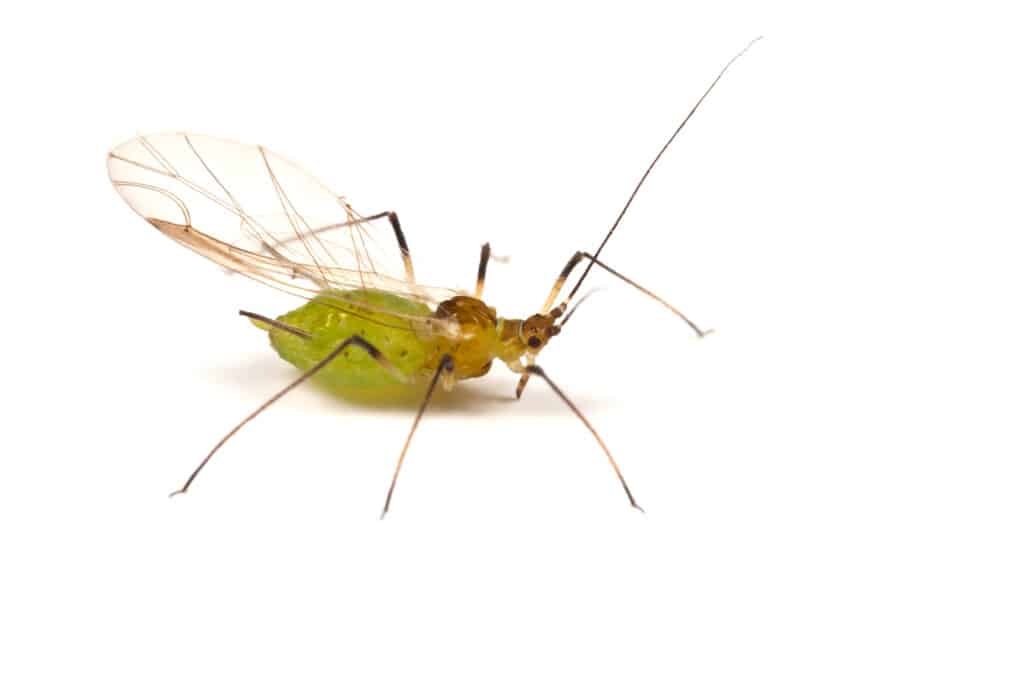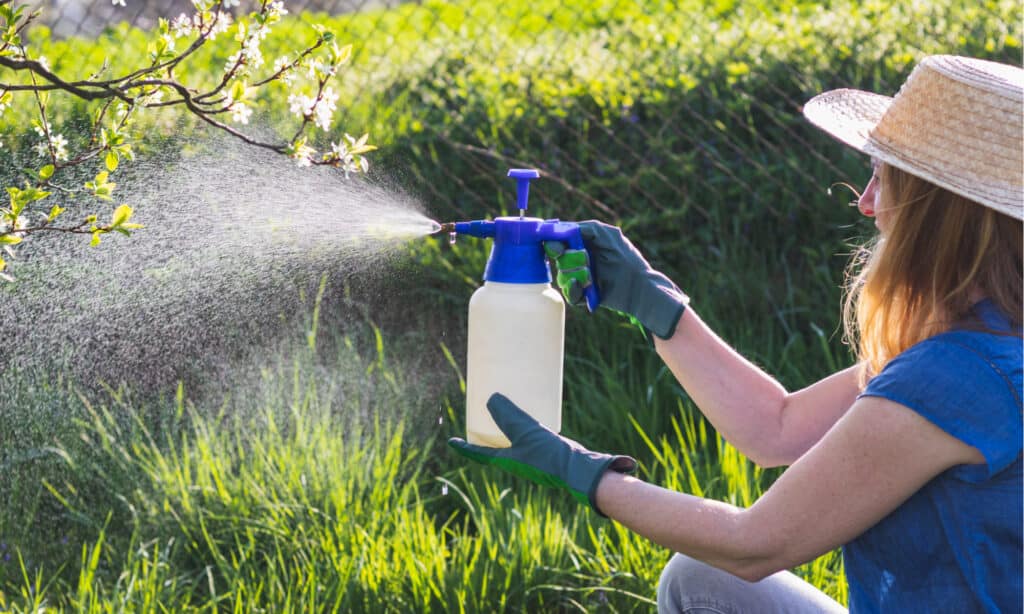If you are an avid farmer or gardener, you may have come across or heard about aphids. Aphids are small pests that infest crops, gardens, and other flora worldwide and feed on the sap of different plants. Not only are they widespread, but there are many different types with diverse characteristics. This article will explore the different types of aphids and will briefly describe how each type might affect your garden. Read on for 7 common types of aphids!
What is an Aphid?

There are roughly 5,000 species of aphid in the family Aphididae.
©Ed Phillips/Shutterstock.com
There are many types of aphid. They are soft bodied insects belonging to the order Hemiptera. This order includes over 80,000 species of “true bugs” such as bed bugs, cicadas, leafhoppers, planthoppers, shield bugs, and aphids. Hemiptera includes 37 families, however, the only extant (not extinct) family of “true aphids” is Aphididae. The family Aphididae includes about 5,000 species of aphids that are in 24 groups called subfamilies. Of the 24 subfamilies in the family Aphididae, we will investigate 7 of the most diverse and prolific below!
Aphids can be troublesome pests because of how quickly they reproduce. Aphids are unique because they can reproduce sexually and asexually. Something particularly interesting is that when an aphid gives birth, they often birth an aphid that is already pregnant by asexual means. Scientists call this telescoping pregnancy and allows generations upon generations to proliferate rapidly.
Where do Aphids Live?

Aphids live all around the world!
©Viacheslav Lopatin/Shutterstock.com
Aphids are sap sucking insects that live in temperate zones. There are approximately 1,350 different species in North America alone. In the United States, aphids primarily live in the southeast and southwest, but can occasionally can live elsewhere. Globally, many aphid species have a Holarctic distribution. Holarctic refers to an area containing two biogeographic realms- the Nearctic (North America) and Palearctic (Euro-Siberian, Mediterranean Basin, Sahara Desert, and Arabian Desert regions). The Nearctic and Palearctic realms together are the Holarctic realm which describes the entire Northern Hemisphere. Aphids that exist worldwide in essentially every appropriate habitat have a “cosmopolitan” distribution, the opposite of an endemic distribution.
Aphidinae

Cabbage aphid, Brevicoryne brassicae, on a tomato plant.
©Holger Kirk/Shutterstock.com
The most prolific type of aphid belong to the family Aphidinae, a name often mistaken for Aphidiinae (a subfamily of small parasitic wasps). Aphidinae is the largest subfamily of aphids that includes 283 genera. Two of the most populous genera are Macrosiphum, and Myzus. In this subfamily there are between 2,500 and 3,200 total species. Most of these species practice host alternation and alternate between host plants based on the season.
Some notable species that cause substantial damage to gardens and crops are cabbage aphids, artichoke aphids, soybean aphids, Tupelo-blackjack aphids, Russian wheat aphids, onion aphids, cannabis aphids, bulb-and-potato aphids, potato aphids, rose aphids, and black bean aphids. The genus Aphis alone includes 600 species, many of which can affect gardens or crops.
Species in this subfamily have variable distribution. The peach-potato aphid is one of the most widely dispersed and economically harmful aphid species. The peach-potato aphid has a near cosmopolitan distribution. Other species in this subfamily have a Holarctic distribution (across the Northern Hemisphere), are restricted to the Nearctic or Palearctic realms (Northern Hemisphere in the new world or old world) or have a completely cosmopolitan distribution. Many Aphids of this subfamily live in North America and the United States.
Giant Aphids (Lachninae)
The subfamily Lachninae earns the nickname “giant aphids” because it includes some of largest bodied aphids. Some scientists even classify this as a separate family from Aphididae. Giant aphids include conifer aphids, giant willow aphids (the largest aphid), aphids of the genus Trama which are notable for only reproducing asexually, and 16 other lesser-known genera. The giant willow aphid can grow up to 5.8 millimeters long! In total, there are 346 species in the Lachninae subfamily, but none of these species are typically harmful to gardens or crops. They can affect woody plant species- for example, giant willow aphids can cause superficial damage to willow trees however it is not life threatening to the tree. Giant aphids live broadly throughout the Northern Hemisphere.
Hormaphidinae
Another type of aphid is the subfamily Hormaphidinae. This subfamily includes three tribes with a total of 42 genera and 231 species. All three tribes include host-alternating species which means that the aphids infest different host plants based on season. Often, aphids inhabit a woody species during sexual reproductive season and a secondary herbaceous species during asexual reproductive season. Some species in this subfamily specialize in conifers, others bamboo, and so forth. However, this subfamily of aphids are not typical garden pests.
Calaphidinae

Aphids can have genetically identical winged and non-winged female offspring.
©Radu Bercan/Shutterstock.com
This sub family is a very common type of aphid. Calaphidinae is the second largest subfamily of aphids that includes 62 genera and 360 species. These include bamboo aphids (genus Takecallis) which describes 7 species. Bamboo aphid species exist only in southeast Asian countries such as Taiwan, China, Japan, India, and Korea. Other genera are also wood feeding species that rely on birches, beeches, walnuts, and elms, and some rely on herbaceous species like plants in the bean and grass families.
Many aphid species in this subfamily have substantial effects on cultivated legume, fruit, and landscaping plants that have economic consequences. Aphids not only infest and feed on the plants, but they are also vectors for diseases. This is very problematic because they have spread from their native distribution across large areas in the Northern Hemisphere.
Woolly aphids (Eriosomatinae)
The next type of aphid are those in the subfamily Eriosomatinae. This family has the appropriate nickname “woolly aphids” due to a filamentous, waxy, white covering they produce that gives them a woolly appearance. The subfamily consists of three tribes, with a total of 54 genera. These include staghorn sumac aphids, woolly apple aphids, amongst many others. Woolly aphids can cause unsightly, superficial damage to plants and are therefore a nuisance to ornamental or decorative plant growers; however, they are not a major threat to gardeners or farmers. Woolly aphids occur throughout the Northern Hemisphere.
Chaitophorinae

A group of aphids feeding on the sap in a leaf.
©Vera Larina/Shutterstock.com
Another type of aphid is the subfamily Chaitophorinae which includes 12 genera and 180 species. Amongst these species are maple aphids which feed on maple trees, and other species that feed on willow trees, horse chestnut trees, grasses, and sedges. They do not significantly affect crop or garden plants and they live broadly across the Northern Hemisphere.
Anoeciinae
A less common type of aphid the subfamily Anoeciinae. This subfamily has one extant genus, Anoecia, and 24 species. This subfamily includes aphids that live underground and feed on plant roots. Anoecia corni, also called dogwood aphid, is known to infest dogwood plants and millet. Anoecia cornicola is also an aphid classified as a pest that infests different grass species as well as corn, sorghum, and pearl millet. Some species remain associated with a primary host plant species, but some Anoeciinae aphids alternate between different host species seasonally. Aphid species of this subfamily exist broadly across the Northern Hemisphere with different species in different continents and countries.
What should you do if you have an aphid infestation?

Woman with spraying a blooming fruit tree to protect against plant diseases and pests.
©encierro/Shutterstock.com
If your garden, crops, or other plants have an aphid infestation, there are several measures that can be taken to remove them. There are a number of insecticides and insecticidal soaps that are effective against aphids. You can also use plant derived oils such as neem and canola oil or you can use white vinegar for more environmentally friendly options. Hosing down the plants with a relatively high water pressure or with soapy water are also effective methods at removing aphids however this is not a permanent solution and must be done repeatedly over a couple of weeks.
If you have an aphid infestation, however, you may not have to get rid of them. Aphids are important components of the ecosystem that play a role in nutrient recycling, interspecies relationships, and as prey to larger insects and small vertebrates. Typically, aphids only cause superficial damage that will not kill the host plant. If you are growing ornamental flowers or have decorative plants infested by aphids, you may want to employ different removal methods, but if your garden can withstand superficial damage, aphids can be a healthy player in the ecosystem.
The photo featured at the top of this post is © schankz/Shutterstock.com
Thank you for reading! Have some feedback for us? Contact the AZ Animals editorial team.






